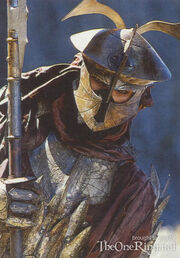
An Easterling soldier in Peter Jackson's The Two Towers.
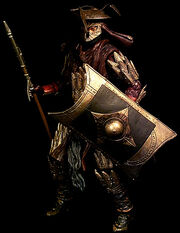
An Easterling, ready for battle
Easterlings, commonly known as the Men of Darkness, were a race of Men who lived in the vast and uncharted lands of Rhûn, east of Mordor and the Sea of Rhun. Easterlings were enemies of the Free Peoples and were allies of Sauron. There were many different nations and kingdoms of Easterlings living in the vast lands of Rhûn. These ranged from civilized empires to barbaric horse nomads of the open steppes.
Description
Easterlings were either tall and sallow-skinned or short and swarthy. However, there were also said to be a different type of Easterlings that appeared during the Siege of Gondor from unknown eastern lands, who were broad, short, and bearded, being perhaps Dwarves from one of four Dwarf clans of the Orocarni in the far East. Easterlings were the most numerous and deadly of the enemies of the Free Peoples, and it is said if the blue wizards had not been sent into Rhûn the hosts of the East would have outnumbered the Western peoples. Their skin was either sallow (a pale yellow) or olive. Their eyes were dark (dark brown and black), slanted, and their straight hair was black. The "swarthier" Easterlings of the First Age and the sallow-skinned men of the Second, Third, and Fourth Ages may have not been a related people, as those of the First may have simply come from the then-unknown lands east of the Blue Mountains, and could have had more relation to the Dunlendings than the later Balchoth and Wainriders.
History
Easterlings of the First Age
During the First Age, the term was applied to the sons of Bór and Ulfang, or the Swarthy Men, who came into Beleriand much later than the Edain, and who were for a part secretly in league with Morgoth. By some men of Dor-lomin that appear in the Wanderings of Hurin, they are called Eastrons.
Sons of Bór
Bór was a leader of Men who came into Lothlann, in Beleriand, during the FA 463. His sons were Borlach, Borlad, and Borthand. Bór was welcomed by Maedhros, who gave him and his followers land north and south of the March of Maedhros. Bór and his sons swore allegiance to Maedhros, and remained faithful, though he was told by Morgoth to betray the banner of Caranthir. All of them were wiped out during the Nirnaeth Arnoediad.
Sons of Ulfang "the Black"
Ulfang also came in Lothlann, Beleriand, in 463, shortly after Bór. He was the father of Ulfast, Ulwarth, and Uldor "the Accursed". Ulfang was welcomed by the sons of Fëanor, and he and his sons swore allegiance to Caranthir. They were given lands to dwell in the north and south of the March of Maedhros. Ulfang and his sons were secretly in the employ of Morgoth, and betrayed the Eldar and Edain during the Nirnaeth Arnoediad in what is now known as the Treachery of Men.
Rule in Hithlum
After Nirnaeth Arnoediad at the bidding of Morgoth, the Easterlings invaded Hithlum. They spread throughout the wide lands plundering, destroying, and killing its inhabitants. The Eldar of Hithlum were able to escape from the invaders by taking refuge in the southern mountains that later the Easterlings avoided out of fear of the Elves. The Easterlings soon withdrew northwards and apparently settled.
However, the Easterlings were betrayed by their lord Morgoth, and locked solely in Hithlum and denied the rich lands of the Beleriand that they so desired. Here the Easterlings governed with cruelty, robbing, stealing, and enslaving the remaining Men of Hithlum, who called the Easterlings the " Incomers". They took away the young and the able bodied and sometimes young women to be wives; the most widely known being Aerin of whom Brodda took to produce his heir. Despite these evil deeds, they did not take Morwen nor her house from her for they feared her and believed her to be a witch and so her son had time to escape to Doriath.'[1] Tuor, the cousin of Túrin was also enslaved in Hithlum by the Easterlings but he was able to escape and evaded them by living as an outlaw, until he was contacted by the Vala Ulmo and went to Gondolin.
The Easterlings ruled effectively in Hithlum as vassals of Morgoth from FA 473 to FA 583. After the War of Wrath, those that survived fled back over the Blue Mountains to Eriador and beyond were they sat themselves up as kings and chieftains of many of the middle men.[2][3]
Easterlings of the Third Age
During the Third Age, the term was applied to the various nations and tribes of Men living in the uncharted lands east of the Sea of Rhûn and Mordor who were usually allied with Sauron (for one of their leaders was the second greatest of the Nazgûl, Khamul) and frequently attacked Gondor and the lands bordering Rhûn. However, Sauron's defeat at the end of the War of the Last Alliance diminished his presence for over one thousand years, and any territorial ambition was left to them alone. In TA 490 they invaded Gondor, passing through Dagorlad and starting a series of wars that lasted sixty years until they were finally defeated in TA 550 by Turambar, the ninth King of Gondor. Afterwards, Gondor subdued some of them and took from them a large area of land between the Kingdom of Rhovanion and Mordor including the Sea of Rhûn.[4][5]
Gondor held on to these territories for a few hundred years but slowly began to lose them over time, and the Easterlings once again initiated warfare. In TA 1248 they once again clashed with Gondor in a series of skirmishes but were still not powerful or organized enough to stand against Gondor’s power.[4] Though defeated the Easterlings would not have to wait long, for Gondor soon fell into decline and civil war. Afterwards, the Easterling tribes remained peaceful for the most part until the mid-nineteenth century when they were again powerful enough to attack the west.
Wainriders

An Easterling soldier at the Black Gates.
The Wainriders were a confederation of Easterling and Haradrim tribes who were united by their hate of Gondor, fueled by the Dark Lord Sauron. Following the Great Plague which weakened Gondor, they started their attacks in TA 1856, defeating an army Gondor army at the Battle of the Plains and killing King Narmacil II. They rode in great chariots (which gave them their name), and raided the lands of Rhovanion, destroying or enslaving its people. Gondor gradually lost all of its possessions east of Anduin to them.
In TA 1899, the thirtieth King of Gondor, Calimehtar son of Narmacil, defeated the Wainriders at Dagorlad, buying some rest for his land. However the Wainriders struck back in TA 1944, allying themselves with the Haradrim of Near Harad and the Variags of Khand. Before this they had been expanding their power southward, beyond Mordor, and had come into conflict with the tribes of Khand and the eastern Haradrim. But eventually these men allied under their universal hate of the West. They managed to kill King Ondoher and all his heirs, but instead of riding on to Minas Anor and taking the city, they paused to celebrate.
Meanwhile, general Eärnil of Gondor's southern army rode north to defend his king defeating an inferior force of Haradrim in South Ithilien, but he came too late to rescue Ondoher, but he did manage to annihilate the Wainriders for good at the Battle of the Camp. Eärnil was crowned king. After this defeat the might of the Wainriders was broken, and they retreated east. They still held Rhovanion, but never troubled Gondor again until the War of the Ring.[6][5][7]
Balchoth
An Easterling
The Balchoth were a fierce race of Easterlings, who attacked Gondor while under orders of Dol Guldur. In TA 2510, they overran the plains of Calenardhon and almost destroyed the army of the Ruling Steward Cirion, but were defeated by the Éothéod under Eorl the Young. Like the Wainriders they rode in chariots and wagons, and they may have been descendants of these people. However, they were notably far more primitive and savage than the advanced Wainriders, so their origin is at most obscure.
The War of the Ring
During the War of the Ring at the end of the Third Age, the Easterlings joined with the forces of Mordor participating in the Northern battles that nearly defeated the Elves of Mirkwood, the Men of Dale, and the Dwarves of the Lonely Mountain.
Armed Easterling
Despite being on the losing side in the War of the Ring, some Easterlings still continued to remain a threat throughout the early Fourth Age but were finally subdued in a series of campaigns led by Elessar. With some of their lands annexed to the Reunited Kingdom, it is presumed that there were no more major invasions to threaten the peace. It is not known whether these men mixed with their former enemies and learned to live in peace or initiated more wars thereafter.
There were many different races of Easterlings that came under Sauron's banner in the War of the Ring. Some were tall and sallow skinned, others short and broad. Some Easterlings who were present at the Battle of Pelennor Fields were short, broad and bearded like Dwarves. During these battles the Easterlings, aside from the hordes of Orcs, were the most numerous and tenacious of Sauron's warriors.
Variags
The Variags (Possibly related to the real world Varangians) were from Khand, and they first appeared in the West in 1856 and than in 1944 of the Third Age, fighting alongside the Wainriders. They later appeared during the Battle of the Pelennor Fields. Tolkien wrote little to nothing about the Variags and Khand; what information we have about them is speculative. It can be gleaned that the Variags were a horse riding people, as they supplied Mordor with horses and brought a large cavalry force to support the Wainriders. It is also possible that, like their real-world namesakes, they wielded large axes and were used as shock troops.[6]
Weapons
Not much is known about the weapons used by the Easterlings. They had as far as it is known spears, bows, axes and chariots. They also seemed to favor the horse on many occasions, although all this probably differed greatly among the Easterling tribes or kingdoms.
Culture
Knowledge of the culture of the Easterlings is limited. In the First Age they could be quite savage; examples of this rise from Brodda's treatment of the Men of the House of Hador in Dor-lómin. In the Third age at least, the Easterlings fought with great valor, as displayed during The Battle of the Pelennor Fields and The Battle of the Black Gate. Even the women fought with the men to defend their homes and children. Easterlings fought with great skill and used many types of psychological warfare.[8]
Portrayal in Adaptations
Peter Jackson's The Two Towers
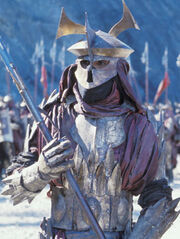
An "Easterling" at the Black Gate.
In the movie The Two Towers, an army from Rhûn is entering the Black Gate. The corresponding passage in the book describes them as Easterlings; in the movie they are the same, quite distinct from the Haradrim passing through Ithilien later in the film.
However, as they carry the banner of Harad, many movie-watchers have been confused between the Haradrim and Easterlings. During this encounter, Sam accidentally falls down a slope where the Easterlings are passing by. Frodo goes after him, and two of the Easterling warriors notice the commotion; they leave the formation to inspect. Frodo hides himself and Sam under his elvish cloak, disguising them as a boulder. The Easterling soldiers almost find them, but eventually return to their legion and march into Mordor.
In the Return of the King they are also seen briefly after the gate of Minas Tirith has been breached. There they advance upon the soldiers of Gondor, but they are not seen fighting.
The Hobbit: The Battle of the Five Armies depicts one of the Nazgul in armor resembling that of the Easterlings; this is undoubtedly intended to be Khamul.
Translations around the World
| Foreign Language | Translated name |
|---|---|
| Chinese (Hong Kong) | 東方人 |
Video games
The Lord of the Rings Online
Easterlings also appear in The Lord of the Rings Online, in the Brown Lands bordering with the Parth Celebrant region, where they established a couple of settlements. They belong to a few tribes: the Balchoth, the Jangovar, the Khundolar, the Variags and the Wainriders.
Uniform, shields, and future
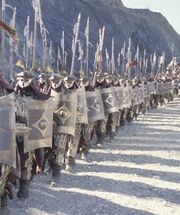
An Easterling army assembled for battle in full uniform with shields and spears.
The armor of the Easterlings entering the Black Gates was made from bronze, along with the helmet; its dragon-skull-shape was made to intimidate enemies.
Their gold or brass overlayed steel lamellar armor consisted of a placard (stomach plate), gorget (heart & neck coverage), groin-plate, rerebraces (upper arm), vambraces (forearm), cuisses (thighs), and poleyns (knees). The clothing that the Men of Rhûn wore consisted of red leather gloves, black leather tall boots, burgundy long pants, a burgundy tunic with long sleeves, a burgundy headscarf, and a black facecloth . The undercut, brass helmet was worn over the headscarf, and featured cheek-and-eye guards, along with two horns from the back and a crest on the front, to remind other beings of dragons, intimidating to the enemy even before the battle began. This primitive form of psychological warfare was terrifyingly effective against the Men of Gondor and Rohan and Dale, who would oftentimes literally quake in their boots at what seemed a golden horde of Easterlings swarming from the farthest East.
During battle, these heavy infantrymen formed the core of Sauron's armies, for they were taller, stronger, better-trained, and better-equipped than the swarming Orcs that fully comprised his forces.
The Men of Rhûn wore their clan-wealth as well: gold, copper, silver, rubies, and other colorful pieces of ornament-material. Easterlings also liked wearing battle trophies, talismans of victory that could inspire them to glory and riches and power and territory/region ownership and totems of fear that would intimidate their next opponents. This psychological warfare struck terror into their enemies and gave them an even greater advantage in battle.

The march of The Easterlings
We are also told within the various writings of Tolkien's legendarium that they were extremely tenacious fighters. After the great rout during the later stages of the Battle of the Pelennor Fields, a relatively small (7000 strong) force of Easterlings stood their ground, with their backs to the River Anduin, and fought to the last man while the host of Mordor fled. They caused sizeable and disproportionate casualties among the Men of the West, and reminded them once again that the Easterlings were dangerous and formidable opponents.
The curved, rectangular, two-foot by three-foot Easterling shield had concave top and bottom edges and was made with brass that surrounded a dark-brown square. It was held by an iron handgrip that was behind a brass circular boss surrounded by a diamond shape that was itself enveloped by the square. It came with a dark-red leather "belt" if the Man of Rhûn was to strap the shield to the forearm for combat requiring two hands. Even archery was allowed by this big strap. One rather striking detail on Rhûnic armor was that a sun was etched into their sternum-plate, resembling a burning of a grassland like Rohan or Dale.
Weapons
Easterlings in full battle gear with the weapons they use, entering Mordor
The Easterlings had three principal weapons: their pike, the scimitar, and the composite bow.
The steel-bladed wooden halberd came in two sizes: the nine-foot halberd was used for porcupine formations and phalanx marches, while the five-foot one was used as a basic soldier's weapon. All halberds were spiked on the top (on the five-foot one it had a pike on the bottom too) and had downward-curving, serrated axe-blades, and below that halberds were backed by a curved spike; on the nine-foot one it was used to trip enemy horses while on the five-foot one it was used for piercing armor and deflecting if not disarming enemy blades. The axe blade featured a hole creating the curve. This was a truly versatile weapon that could be used both offensively and defensively.
The three-foot-bladed steel scimitar was carried by all troops as a secondary weapon (except in the case of Swordsmen). The curved blade was used in a downward, diagonal slashing attack and for thrusting. No matter which method of attack the Easterling chose to use with his scimitar, it was extremely effective in his hands. The scimitars were particularly suited for mounted attacks, as they were long and curved, allowing the rider to swing and hit his foes.
The Composite Bow of the Easterlings was made of multiple layers of wood and was of a recurve type. They were 4 feet long at the very most, and they were carried in holsters. The arrows had hawk feathers, and the tips were forged out of steel. Easterling cavalry archers were uniquely skilled, and while riding kept their quivers slung at their sides. They learned to stand up in the saddle and release their arrows at the moment the horse's hooves were off the ground, allowing them to shoot more accurately than Rohan's horse archers. They also have three-foot-wide rectangular shields in the movie.
Non-Canonical military units
Kataphrakts
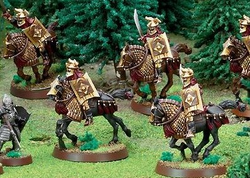
Easterling Kataphrakt models from the The Lord of the Rings Strategy Battle Game.1
The Easterlings were known for their unique type of cavalry known as kataphrakts. These were Easterlings that mounted upon heavily armored horses and wielded a scimitar and broad shield. They were notorious for their ferocity of their attacks and the sheer amount of defensive power that these troops could summon when they were deployed side-by-side. The brass lamellar armor on the fronts of their horses allowed them to safely trample spearmen and pikemen. Rhunic composite shortbows were sometimes taken instead of shields. The name Kataphrakts is possibly based on the Savaran Cataphracts, which were also heavily armored cavalry troops of the Sassanid Persian Empire. They could also be based off of Mongol Keshiks and Ottoman Sipahis, as the way the horse is armored and how the warrior on its back fights are highly suggestive of this. They were featured in the The Lord of the Rings Strategy Battle Game.
Inspiration
Movies
In Peter Jackson's film series, the Easterlings have a heavy oriental look. In the appedecies of the Special Extended Edition, the artists claim that they were inspired by a variety of Asian cultures, particularly Sassanid Persians, Mongol Horsemen, Japanese Samurai, and Ottoman Turks. They have "crests" on the backs of their coolie hat-like helmets that resemble feudal Samurai crests. They also bear a rising sun emblem upon their armor. Also, under their armor they wear veils, headscarves, and robes, suggesting a Southwest Asian influence. In some movie models, their boots have upturned toes, suggesting a Mongolic or Persian influence.
Easterlings marching within Sauron's Orcish armies.
References
- ↑ The Children of Húrin
- ↑ The Silmarillion: Quenta Silmarillion
- ↑ The Atlas of Middle-earth, The Second Age, "Refugee Relocation"
- ↑ 4.0 4.1 The Lord of the Rings, Appendix A: Annals of the Kings and Rulers, I: The Númenórean Kings, (iv): "Gondor and the Heirs of Anárion"
- ↑ 5.0 5.1 The Lord of the Rings, Appendix B: The Tale of Years (Chronology of the Westlands), "The Third Age"
- ↑ 6.0 6.1 Unfinished Tales, Part Three: The Third Age, II: "Cirion and Eorl and the Friendship of Gondor and Rohan"
- ↑ The Atlas of Middle-earth, The Third Age, "Wainriders and Angmar"
- ↑ The Complete Guide to Middle-earth
